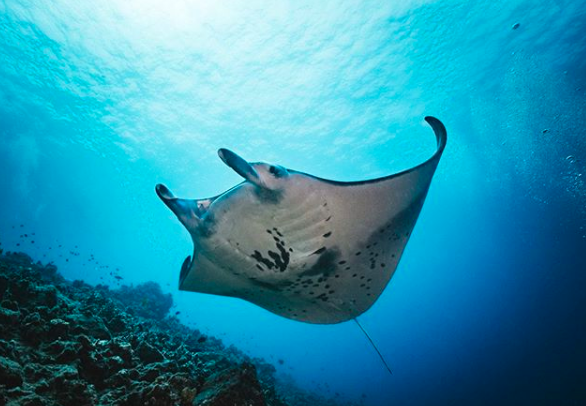Swimming with manta rays in a new light.
Some places in the world are fortunate enough to have unique wildlife encounters. In Hawaii, it’s about experiencing and swimming with the manta rays in a whole new light – at night.
The incredible luck of seeing manta rays flirting with Hawaii’s Big Island coastline under the stars was an accidental discovery – and one that many avid marine lovers celebrate its surreal find.
The Big Island’s manta ray population received a boost after the completion of the Sheraton Kona Resort & Spa at Keauhou Bay in the 1970s. In creating its nightly seaside ambience, the resort had installed lights to illuminate its lava-strewn coast. In turn, these lights attracted marine plankton, and much to tourist delight, ocean vacuum cleaners – manta rays – feed off plankton. (The manta rays eat plankton by using their brachial filters to sift food out of ocean water.)
In the presence of light and plankton, the area became a hotbed for these gracious creatures to roam. Fast forward today, the Big Island’s Kona coast’s ‘rays by the bay’ is rated one of the world’s top night diving experiences.
To get up close to the graceful manta rays, I went into the depths of the sea with Big Island Divers to have my unreal encounter with the Big Island’s famous creatures of the night.
Related reads: United States travel
It was after 7 pm when I began my dive into the ocean’s darkness with a torch in tow to experience the majesties of the manta rays under a blanket of stars. Descending several metres underwater, I was instructed by an accompanying guide to sit along the ocean floor. Here I joined other curious divers eager to see the manta rays frolicking in their natural habitat.
Manta rays are related to the shark family; however (lucky for us), they are friendly creatures that do no harm. The largest of the ray family, their wingspan can reach up to 8 metres in width, and they can weigh over 1500 kilograms. The oceanic beats can dive more than 1000 metres below sea level however they prefer to cruise around 10 metres deep.
It was as if the manta ray experience was a timed stage performance. Us divers were eagerly pointing our torches to spot these friendly rays appear in our midst. We didn’t have to wait long until this incredible night show commenced.
As soon as all the divers were seated in a circle formation, the star of the show emerged. With a wingspan of four to five metres, a sole manta ray glided its way over the 10-metre wide circle and continued to closely soar over us, gliding back and forth over our heads to opposing ends of the circle.
It was as if our dive circle acted as a circus ring barrier that the manta ray was constrained to, swimming less than a metre over us.
I was utterly mesmerised with the manta ray’s flirtatious belly dancing as it rose from the ocean floor to turn and parade itself. There were moments where I had to move my body, as to not receive a hit to the head by the manta ray’s enormous wing as it somersaulted moments away. Soon enough, the manta ray was curious to go elsewhere and left the circle much to my (and I imagine others) disarray.
The next encounter was a timely execution. As soon as the manta ray sashayed into the distance, its presence was swiftly replaced. A massive school of silverfish descended into the middle of the circle. It was an uncanny yet fantastic intermission of sorts.
Ever gracious, the manta ray would soon reappear to join the school of fish spectacle. The manta ray would repeat what it had done previously, swimming towards and away from my general direction. It was just short of our 45-minute dive where the manta ray grew tired of being the star of the sea and would call it a day. Maybe it was just as well as the water, despite our thick wet suits, started to get a bit too cold for my liking.
Soon enough, we ascended and made our way towards the boat slowly. Even aboard the boat, you could still spot the manta rays wing-flapping frenzy under the bright lights of other boats, snorkelers and divers alike.
It may have been a starry evening however it was the manta ray’s stellar performance that lit up the night.
The details
Big Island Divers offers both snorkel and scuba dives with the manta rays. Prices start from USD115 per snorkeler and USD139 per scuba diver.
See more: United States travel
Featured Image: Big Island Divers
Julia was a guest of Hawai‘i Tourism Oceania and Big Island Divers and all thoughts and opinions are of her own.






